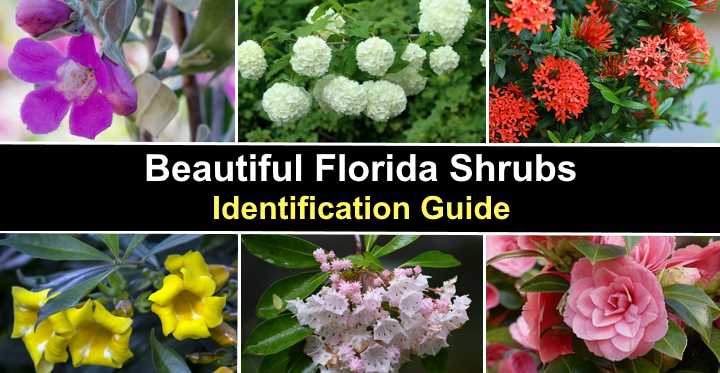In Florida, gardens are enhanced by the presence of shrubs, blossoming bushes, evergreen plants, and trailing vines. The state’s warm and humid climate supports a variety of shrubs that thrive in both sun and shade. Some popular flowering shrubs in Florida include viburnum, bougainvillea, ixora, pinwheel jasmine, hibiscus, Bolivian sunset, and cape honeysuckle. Evergreen plants such as croton, copperleaf, American beautyberry, and nandina also contribute to Florida’s diverse flora.
Growing shrubs in Florida can be challenging due to the region’s varying climate conditions. The northern part of the state experiences colder winters and stronger coastal winds, while the constant heat and humidity in Central and South Florida can make maintaining garden shrubs difficult. Fortunately, the southeastern states boast a range of native and non-native plants that thrive in the area.
This article highlights the best shrubs and bushes for cultivation in Florida. By exploring descriptions and visuals of blooming and evergreen bushes, you can more easily determine the garden plants that will thrive in your sun-soaked landscape.
Growing Zones in Florida
The state of Florida, located in the southeastern United States, encompasses three main growing zones: North Florida, Central Florida, and South Florida. North Florida falls within USDA zones 8 and 9, encompassing the Florida Panhandle and sharing a climate with southern states like Alabama, Georgia, Mississippi, and Louisiana. Cities such as Tallahassee, Pensacola, and Jacksonville are part of these zones, which experience brief, mild winters and extended, warm summers in a subtropical climate.
Central Florida spans USDA growing zones 9a to 10a, including cities like Orlando, Daytona Beach, and Tampa Bay. This region of the Sunshine State enjoys a year-round subtropical climate, with the wet season in May and June bringing plentiful rainfall. South Florida, on the other hand, falls within USDA zones 10 and 11, featuring cities such as Miami, Fort Lauderdale, the Florida Keys, and various Gulf Coast regions. Boasting an average temperature of around 80°F (26°C), South Florida’s climate is distinctly tropical.
Flowering Shrubs In Florida
Incorporating shrubs into your Florida garden can greatly improve its appearance. Shrubs not only contribute vibrant hues and elegance to your outdoor space, but they can also serve as foundational elements to enhance your home’s visual appeal. Additionally, they can be utilized to create evergreen hedges or attractive borders.
Texas Sage (Leucophyllum frutescens)
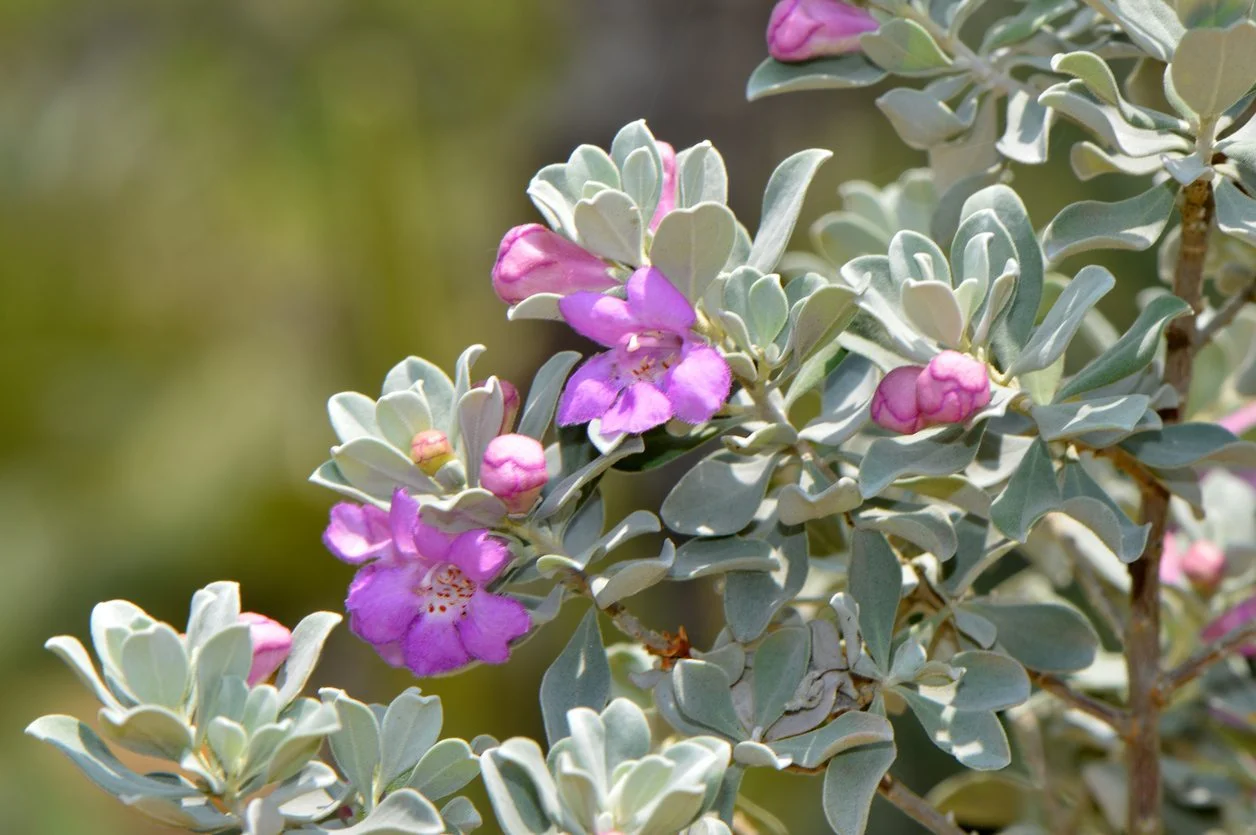
The Texas sage, featuring compact silvery-gray fuzzy leaves and small purple flowers, is an evergreen shrub that brings a touch of sparkle to landscapes in North and Central Florida. This rounded, mounding plant produces petite, funnel- or bell-shaped blooms in Florida, particularly following rain. It is a suitable shrub choice for North and Central Florida.
Growing in full sun, Texas sage can reach heights of 5 to 8 feet (1.5 to 2.4 meters) and widths of 4 to 6 feet (1.2 to 1.8 meters). The optimal growing conditions for this Florida shrub include low humidity and well-drained soil. Texas sage is remarkably heat and drought-tolerant. It is also known as Texas Silverleaf, wild lilac, Texas Rain Sage, and Texas Barometer Bush.
Hardiness zones: 8 to 10
Sun exposure: Full sun
Bougainvillea
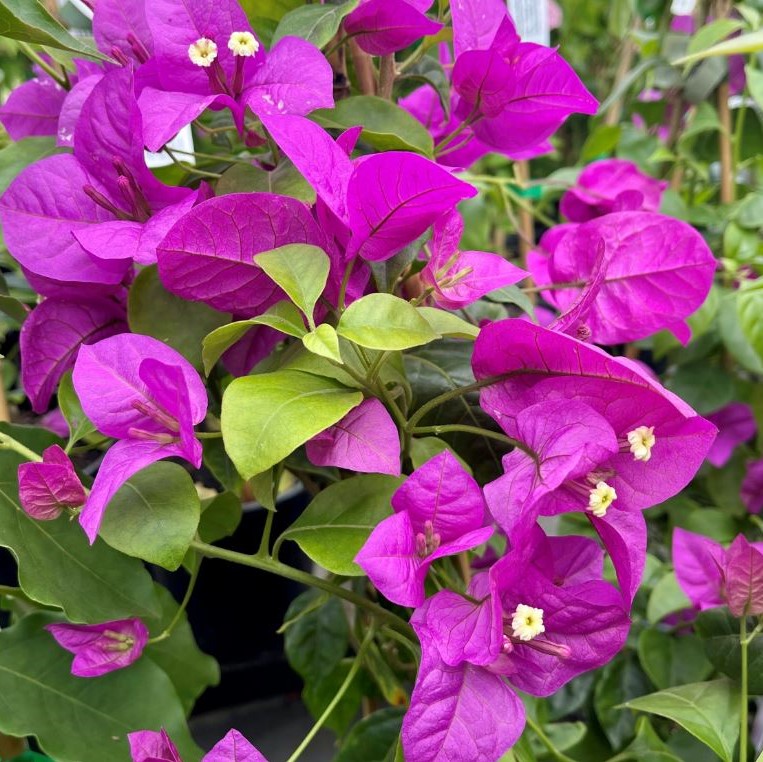
Bougainvillea is a vibrant, flowering tropical shrub available in various colors, making it an ideal choice for South Florida gardens. Its striking blooms, which come in shades of pink, purple, orange, or deep red, flourish under full sunlight. In Florida landscaping, bougainvillea can be used to adorn walls, serve as a foundation bed, or grow over an arbor.
Reaching up to 40 feet (12 meters) in height and width, bougainvillea is a flowering evergreen shrub that benefits from proper pruning. Alternatively, you can let the vine grow and spread naturally. This shrub is an excellent fit for Florida gardens due to its ability to tolerate both full sun and high humidity.
Hardiness zones: 10 – 12
Sun exposure: Full sun
Hibiscus
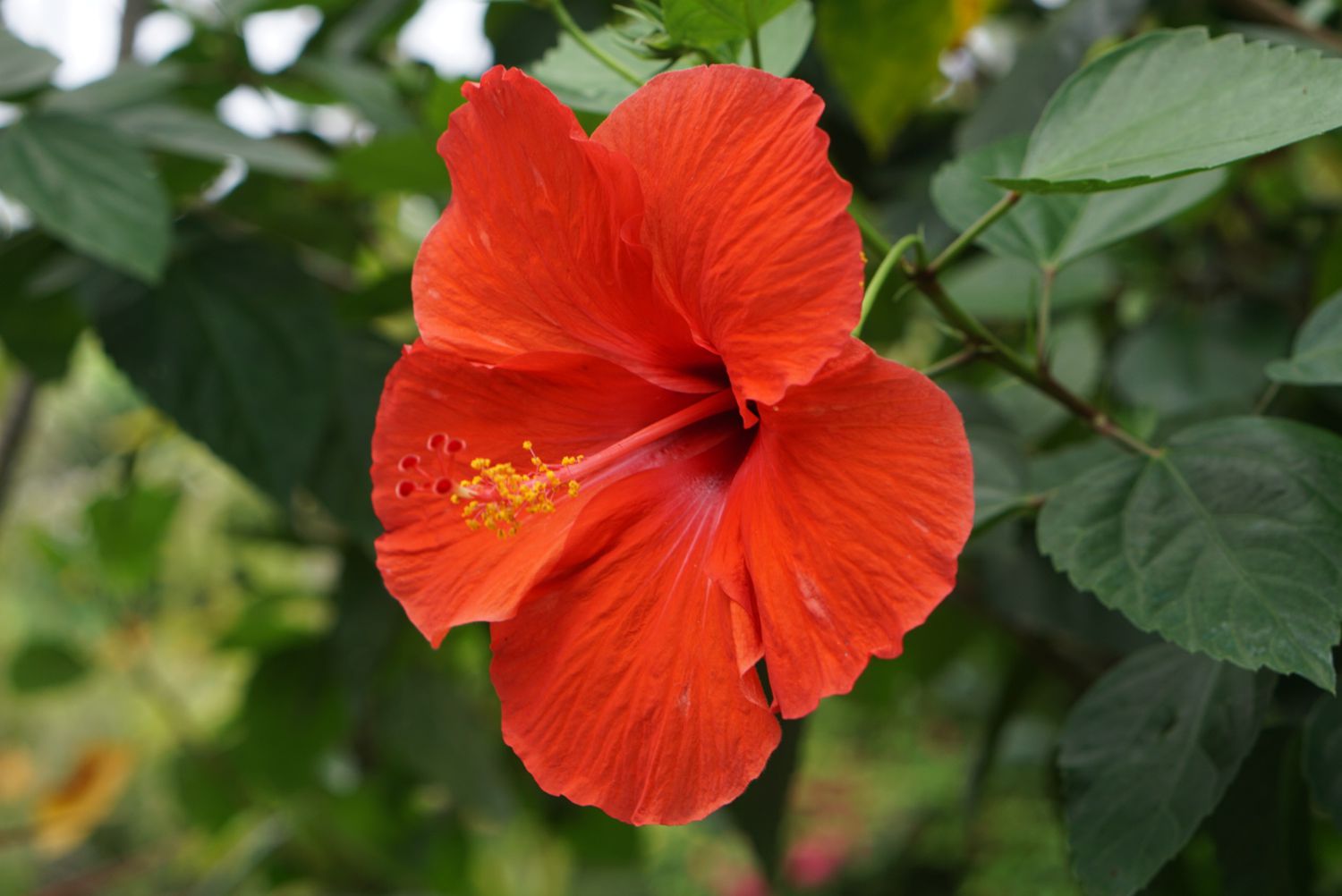
Hibiscus rosa-sinensis, commonly referred to as rosemallows, is a type of tropical hibiscus plant that flourishes in Central and South Florida. The large, pastel-colored flowers on these evergreen bushes, which can be up to 10″ (25 cm) wide, are well-known for their beauty. Hibiscus flowers come in various forms, from trumpet-shaped to showy double blossoms with frilled petals.
For North Florida, hardy hibiscus plants featuring large, vibrant funnel-shaped flowers are recommended. These lush, dense plants develop into compact mounding perennials and thrive in USDA zones 5 to 9. Native tropical hibiscus bushes are best suited for Central and South Florida. These sun-loving mounding plants can reach heights of 4 to 6 feet (1.2 to 1.8 meters) and widths of 3 feet (1 meter). Tropical hibiscus plants thrive in growing zones 8 to 10.
Hardiness zones: 5 to 10, depending on the species
Sun exposure: Full sun
Ixora (Ixora coccinea)
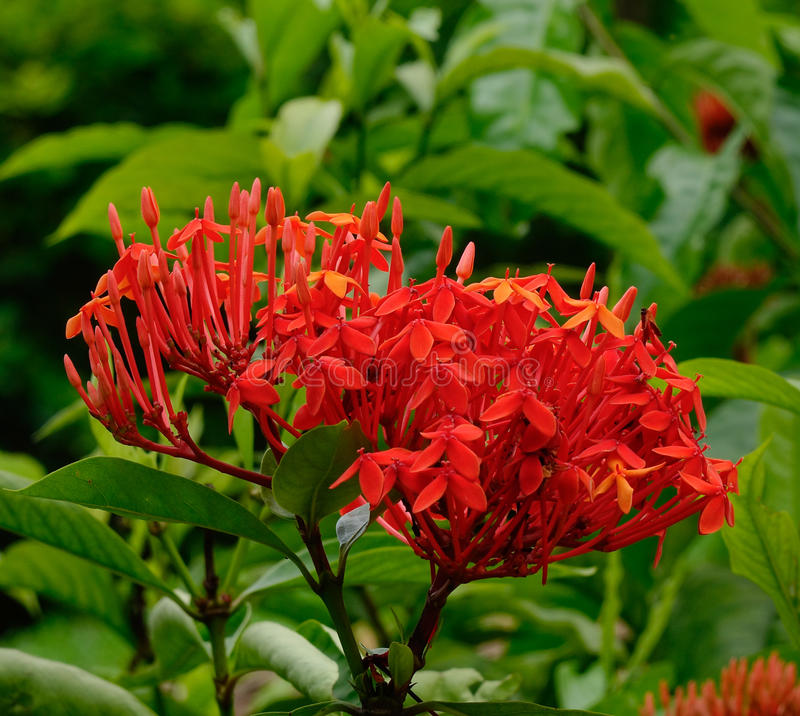
Ixora is a tropical year-round blooming Florida shrub with huge cymes of bright star-shaped flowers that may be used for hedges or foundation plants in the central and south regions. White, pink, yellow, red, and orange blooms may be found on Ixora bushes.
Ixora bushes may grow 10 to 15 feet (3 – 4.5 meters) tall and broad, with leathery lance-shaped leaves and blossoms 5 inches (13 cm) wide. As a border, evergreen screen, hedge, or specimen shrub, Ixora is ideal for planting in Florida gardens. At the end of long woody stalks, long-blooming star-shaped blooms appear. The plant thrives in Central and South Florida, being drought tolerant and salt tolerant. Ixora bushes may be grown in a pot in North Florida and the Panhandle.
Hardiness zones: 10 and 11
Sun exposure: Full sun to partial shade
Oakleaf Hydrangea (Hydrangea quercifolia)

Oakleaf hydrangea is a deciduous flowering shrub indigenous to North Florida, known for its stunning white blossoms. The eye-catching feature of these hydrangea bushes is the pyramidal clusters of white flowers, which can grow up to 12 inches (30 cm) long. The large lobed, dark-green leaves that resemble oak leaves serve as a distinguishing trait for these hydrangeas. Blooming from late spring to summer, oakleaf hydrangea perennial shrubs are native to Florida. The bush’s dense, rounded form and attractive green foliage make it versatile for use as a hedge, foundation planting, backdrop, or accent shrub.
Hardiness zones: 5 to 9
Sun exposure: Full sun to partial sun
Mountain Laurel (Kalmia latifolia)
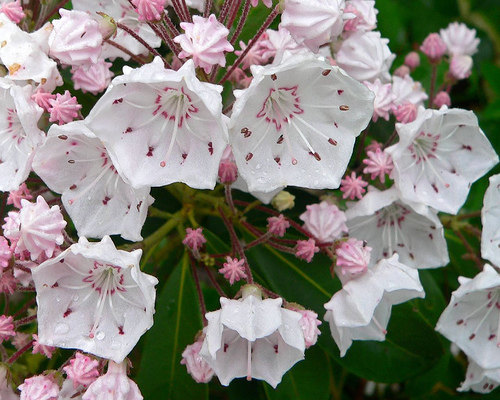
Mountain laurel is a bushy, multi-stemmed shrub that produces an abundance of light pink flowers with dark rose markings in late spring. This plant can tolerate some shade and is well-suited for North Florida gardens. The eye-catching, bell-shaped blooms are accompanied by leathery, glossy green oval leaves on the deciduous shrubs.
Mountain laurel can grow to heights ranging from 5 to 15 feet (1.5 to 4.5 meters). This winter-hardy flowering bush is native to the eastern United States, including the northernmost regions of Florida. You can cultivate this shade-loving shrub as a specimen plant, within a shrub border, or as part of a cottage garden.
Hardiness zones: 4 to 9
Sun exposure: Partial sun
Camellias

Camellias are a collection of bushy evergreen shrubs known for their beautiful, glossy leaves and vibrant winter blooms, which flourish in partial shade in North Florida gardens. These resilient shrubs can grow to heights of 6 to 10 feet (1.8 meters), making them perfect for shaded Florida gardens.
Ideal for use as an evergreen hedge, accent plant, foundation planting, or screen in North Florida landscapes, Camellia flowering shrubs are well-regarded for their intriguing shapes and evergreen foliage. These long-lived plants are popular choices for landscaping, and they are also low-maintenance.
Hardiness zones: 7 to 9
Sun exposure: Partial shade
Firespike (Odontonema cuspidatum)
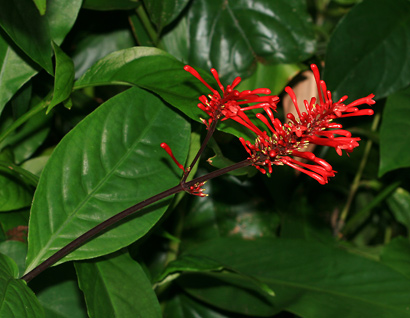
Firespike is a shrub that blooms year-round in Florida gardens and serves as a perennial shrub in Central and North Florida. Its tubular flowers are a vivid crimson red and form as flowering spikes. The shrub can reach a height of 6 feet (1.8 meters) and bears 12-inch (30 cm) flower spikes.
Although Firespike can grow in partial shade, it thrives best in full sun and is commonly found in Florida gardens. This clumping herbaceous perennial shrub is perfect as an anchor plant at the back of a garden bed. It flourishes in all Florida climates and exhibits drought tolerance.
Hardiness zones: 9 to 11
Sun exposure: Full sun to partial shade
Viburnum

Viburnum is a versatile shrub that can grow up to 10 to 12 feet (3 to 3.6 meters) tall as a small tree or shrub, making it perfect for Florida gardens to attract pollinators, birds, and wildlife. With clusters of small, fragrant white flowers and glossy dark green leaves, this low-maintenance, drought-resistant plant is an excellent choice.
In a subtropical Florida garden, Viburnum shrubs are ideal for winter flowering, with flower clusters appearing in spherical, domed, or conical forms in shades of pink, green, white, and rose. Dwarf Viburnum bushes are ideal for small gardens with limited space, growing 1 to 5 feet (0.3 to 1.5 meters) tall with attractive flower clusters and showy berries.
Hardiness zones: 7 to 9, but some varieties of Viburnum are also cold-hardy in zones 8 to 10.
Sun exposure: Full sun to partial sun.
Bolivian Sunset (Gloxinia sylvatica)
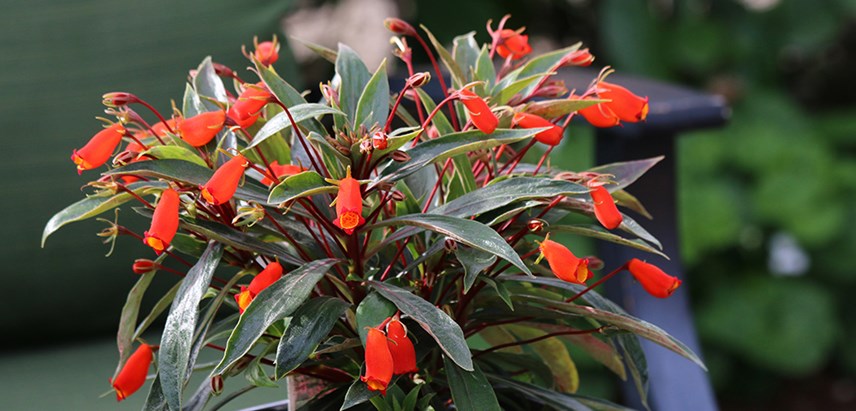
Bolivian sunset is a small, low-growing shrub that is suitable for frost-free regions of Florida. This flowering shrub is distinguished by its glossy, dark-green leaves and tubular red-orange blooms. The Bolivian sunset is a small plant, growing up to 3 ft. (1 m) tall, making it ideal for container gardening in colder climates. It grows well in both sunny and shaded beds and borders in subtropical climates. Additionally, the spreading shrub can be used as ground cover in full sun or shade.
Hardiness zones: 9 to 11
Sun exposure: Full sun to partial shade
Elderberry (Sambucus nigra ssp. canadensis)
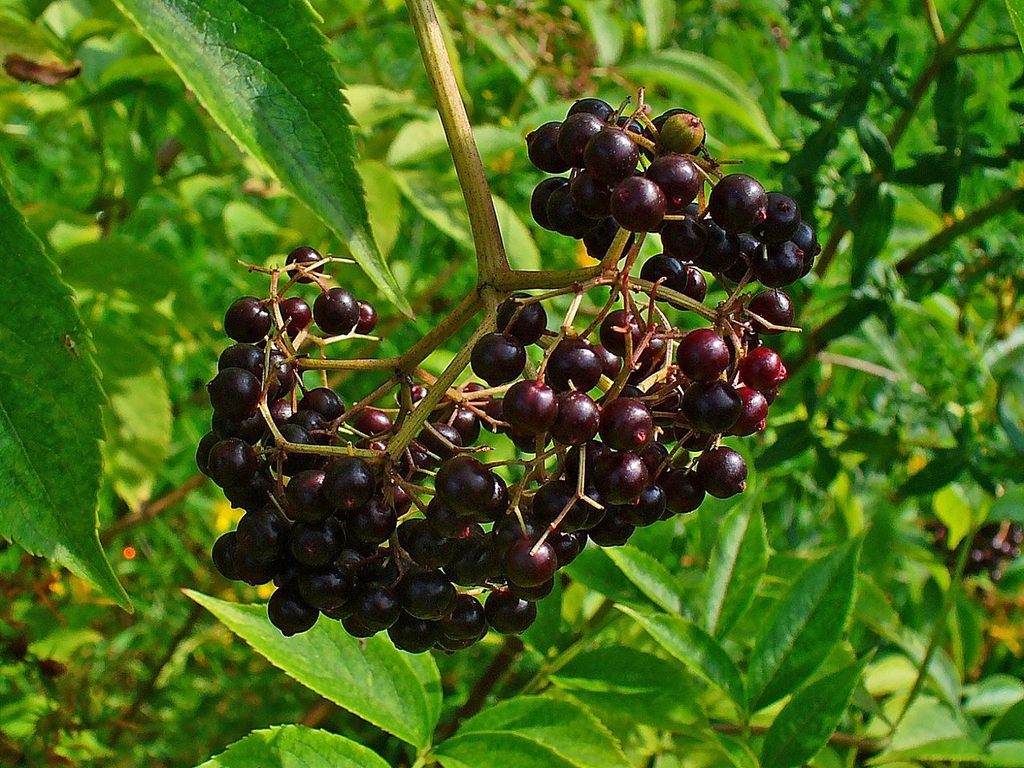
Elderberry is an evergreen species that grows in south Florida. It blooms from the middle to late summer, and its clusters of brilliant white flowers are famous. When the flowers are gone, the tree produces purple and black berries, which can be seen throughout the year in South Florida, remaining evergreen.
Elderberry bushes have great decorative value in garden landscapes and can grow up to 10 feet (3 meters) tall. The deciduous or evergreen plant can grow in a range of soils and climates. Elderflower can be cultivated as a naturalized area hedge plant, barrier, or shrub.
Hardiness zones: 4 to 10
Sun exposure: Full sun to partial shade
Allamanda Bush (Allamanda schottii)
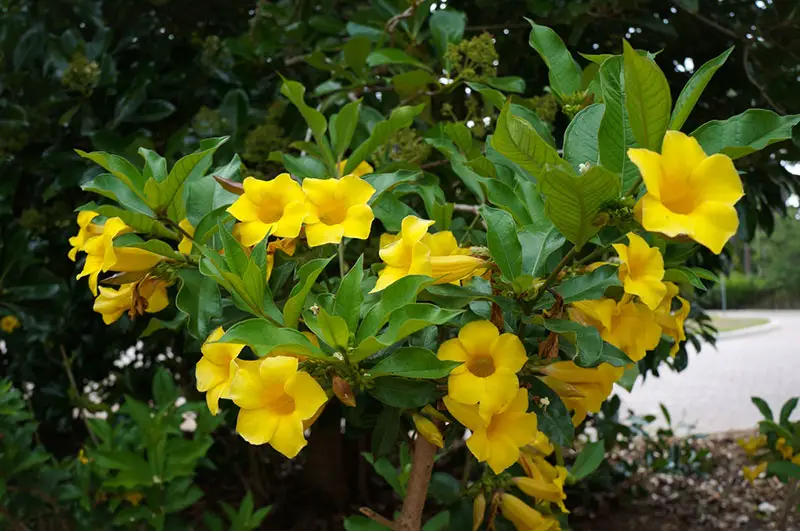
The allamanda shrub is a tropical evergreen plant with stunning golden-yellow funnel-shaped flowers that add a splash of color to south Florida landscapes. This long-blooming shrub is in bloom from late spring to autumn, and its dark green, lance-shaped leaves create a stunning contrast to the bright yellow flower clusters. The allamanda bush is a decorative shrub that grows to be 4 to 5 feet (1.2 – 1.5 meters) tall.
The allamanda bush is known for its pointed green leaves, beautiful yellow flowers, and year-round color. This shrub is an ideal choice for a privacy hedge, corner accent, garden bed anchor, or specimen shrub, and it thrives in full sun to partial shade in Florida gardens.
Hardiness zones: 10 and 11
Sun exposure: Full sun to light shade
Angel’s Trumpet (Brugmansia)
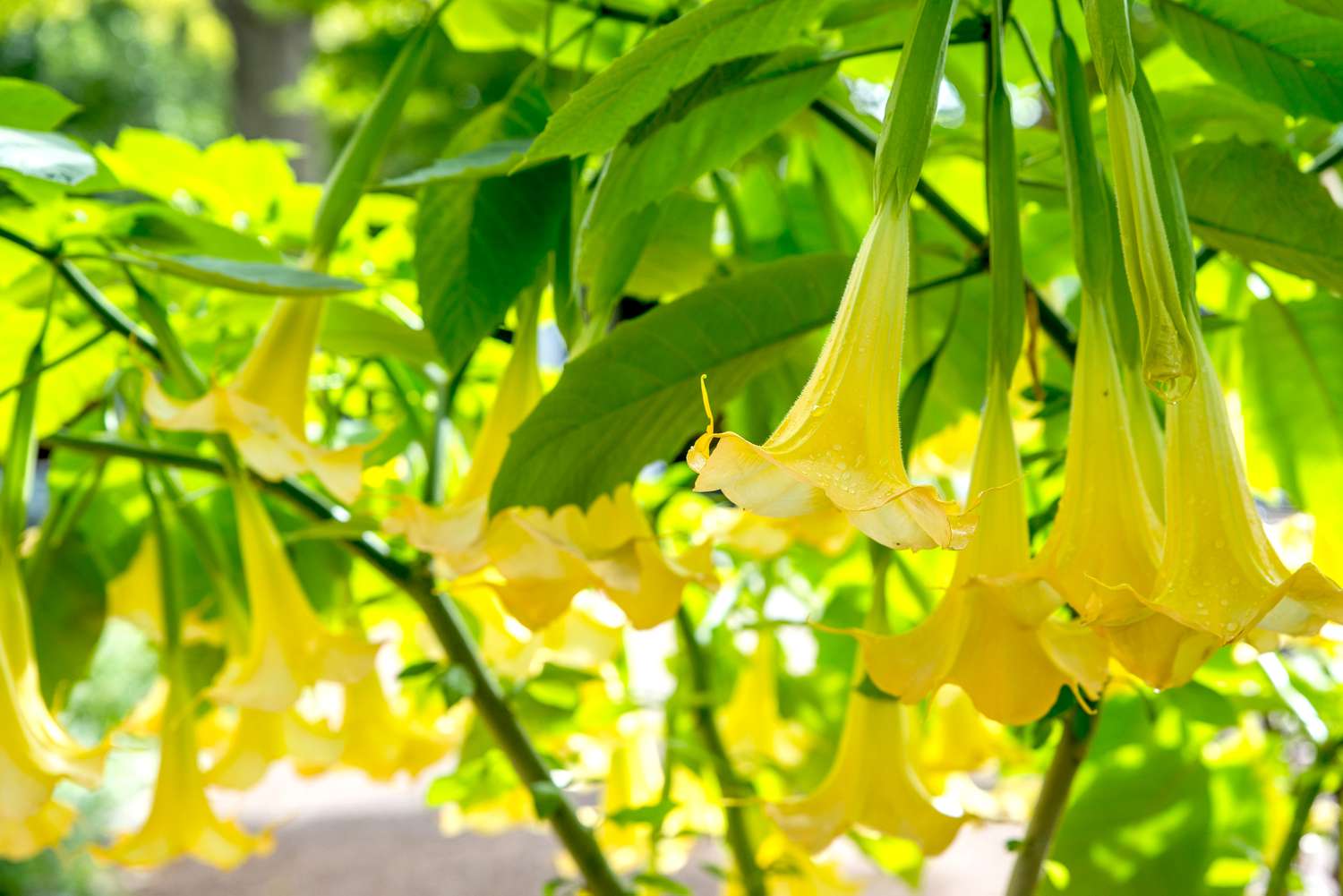
Angel’s trumpet is a large shrub with elongated trumpet-shaped yellow and orange-red flowers that dangle from long pendulous stems. It thrives in sunny or partly shaded areas. The long leaves, which are 4″ – 12″ (10 – 30 cm) in length, and the large fragrant blooms that can reach up to 20″ (50 cm) in length are the distinguishing characteristics of the Angel’s trumpet shrub. The plant can grow up to 10 to 36 feet (3 to 11 m) in height and is classified as a large shrub.
Angel’s trumpet belongs to the nightshade family and is poisonous to all parts of the plant. It thrives in hot and humid climates and is often grown as a specimen plant with large leaves in South Florida. However, it is recommended to keep the plant away from children’s play areas or edible crops to minimize the risk of poisoning.
Hardiness zones: 9 to 11
Sun exposure: Full sun to partial shade
Azalea

Azalea honeysuckle, also known as Rhododendron luteum, is a fragrant flowering shrub that can grow up to 10-13 feet (3-4 meters) tall in Central and North Florida. Azalea blooms are showy and come in a range of colors, including red, pink, and white. The size of a single blossom can vary from 0.25 inch (6 mm) to 5 inches (12 cm).
Native azalea bushes in Florida originate from Asia. Bush honeysuckle is the best native azalea for Florida, with small, fragrant flowers and pointed, lance-shaped leaves. Azaleas prefer some shade and can grow between 8 and 10 feet (2.4 to 3 meters) tall.
Chapman’s Azalea (Rhododendron chapmanii) is another native Florida azalea, which is an evergreen shrub with small leaves and pink blooms that are 0.5 inch to 1 inch (1.2 to 2.5 cm) in size.
Hardiness zones: 8 and 9
Sun exposure: Partial shade to partial sun
Butterfly Bush (Buddleia davidii)
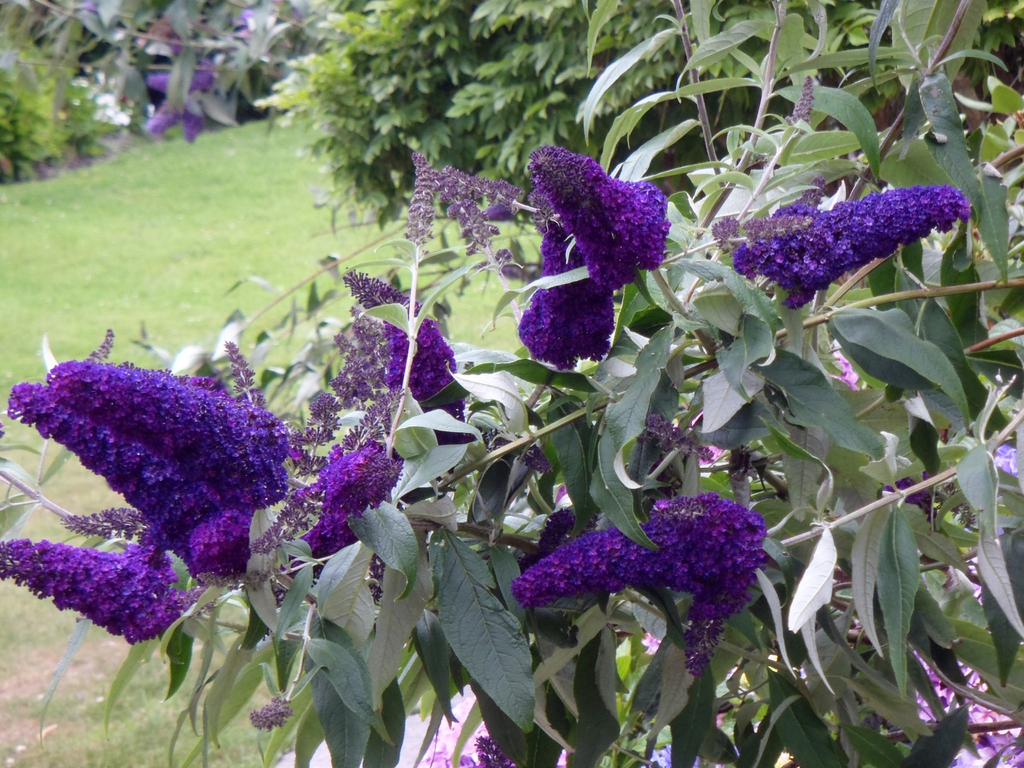
Buddleia, also known as Summer Lilac and Orange Eye, is an ideal plant for attracting pollinators to Florida gardens. Although blooming bushes perform well in Florida, high humidity can make them susceptible to various foliar diseases. Buddleia is often used as an informal hedge, planted along a fence, or lining a driveway or walkway.
Hardiness zones: 5 to 8
Sun exposure: Full sun
Pinwheel Jasmine (Tabernaemontana divaricata)

Pinwheel Jasmine is a popular shrub that can be found in Florida, which thrives in both full sun and partial shade, and it has bright green leaves and white star-shaped flowers that bloom abundantly. This is a flowering shrub that is ideal for partial shade or partial sun cultivation in Florida. The shiny leaves on this beautiful plant can grow up to 5 feet (1.5 meters) in height and width.
The unique white flowers of the Pinwheel Jasmine are immediately recognizable, as they are arranged in a pinwheel pattern, giving this evergreen shrub its name. Additionally, ornamental cultivars of the shrub with small clusters of double-colored blooms are available. Although it is a spring-blooming shrub, it will bloom throughout the year in Central and South Florida. Other names for the Pinwheel Jasmine shrub include crepe jasmine, Nero’s crown, and East India rosebay. Despite its common name, this plant is not related to the jasmine plants of the Jasminum genus.
Hardiness zones: 9 to 11
Sun exposure: Full sun to partial shade
Cape Honeysuckle (Tecoma capensis)
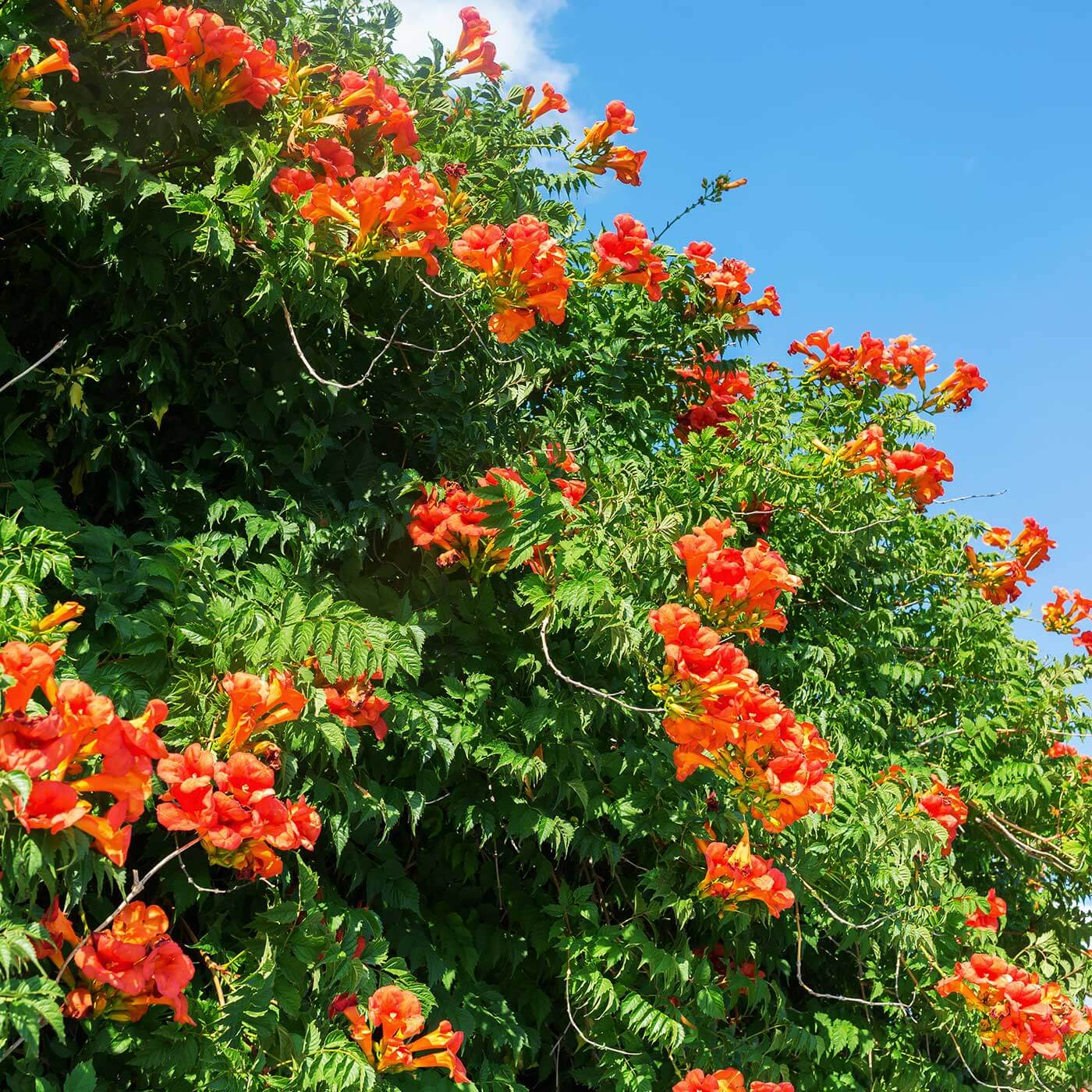
Cape honeysuckle is a sprawling shrub that can be used as a living barrier in Florida gardens. It is characterized by orange or orange-red tubular blooms that are 3 inches (7.5 cm) long, as well as dark green pinnately compound leaves with serrated borders that are 6 inches (15 cm) long. Cape honeysuckle can grow up to 7 to 10 feet (2 to 3 meters) tall and wide. Although it is not a vining plant, it can grow up to 25 feet (7.5 meters) wide due to its scrambling habit. This drought-tolerant shrub can be grown as a flowering evergreen hedge or privacy screen. It can also climb trellises, arbors, pergolas, walls, and fences.
Hardiness zones: 9 to 11
Sun exposure: Full sun to partial shade
Cape Jasmine (Gardenia jasminoides)
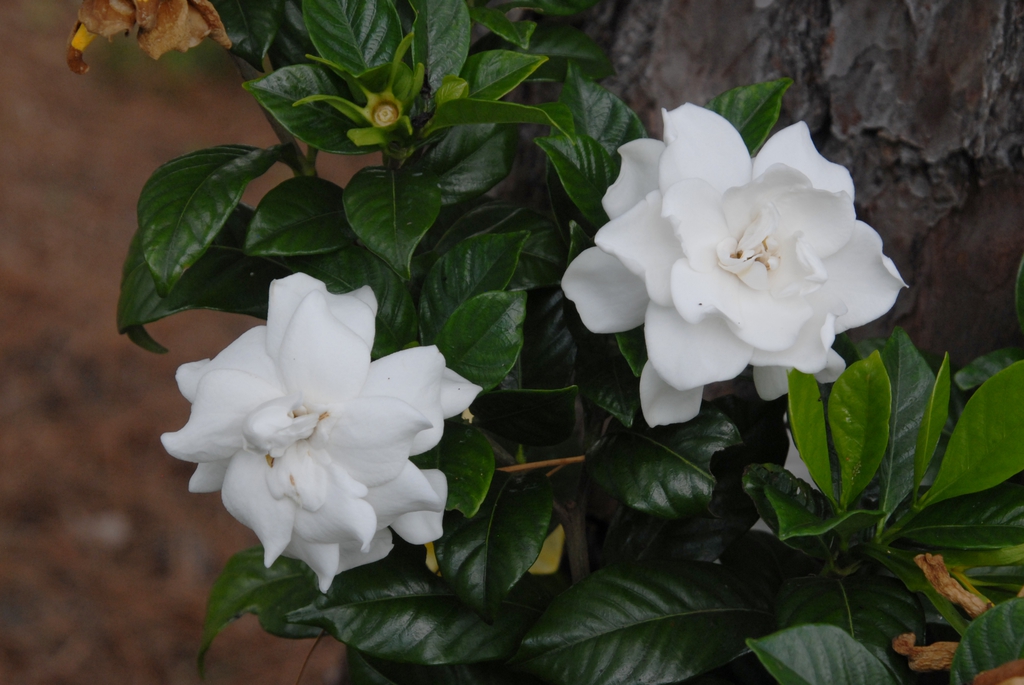
Cape jasmine is an evergreen shrub that grows well in Florida’s subtropical climate. The plant features thick, glossy green leaves and lovely white, waxy blooms that produce a pleasant fragrance. The lance-shaped leaves of the jasmine measure 1.2″ to 10″ (7.6 – 25 cm) in length and can reach up to 1″ in width.
The funnel-shaped blooms of Cape jasmine are white in color and can grow up to 4″ (10 cm) in size. The plant thrives in full sun or partial shade and prefers fertile, moist soil. It can be used as a privacy screen, hedge, or border plant to add beauty to the garden landscape.
Hardiness zones: 7 to 11
Sun exposure: Full sun to partial shade
Oleander (Nerium oleander)
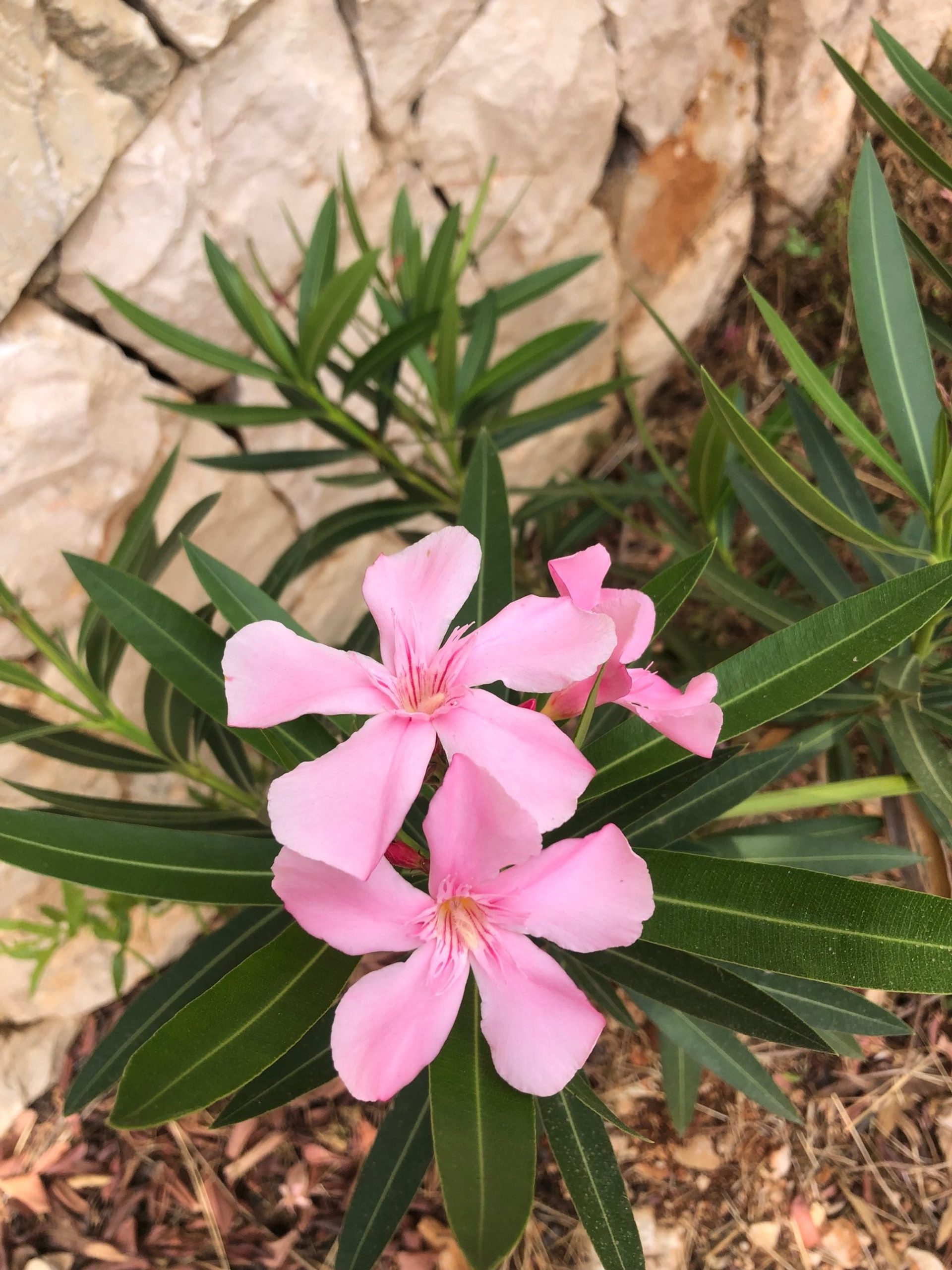
Oleander is a flowering shrub that produces flowers of different colors and can be grown in all regions of Florida. The plant has a beautiful spreading shape that results from its fast growth and multi-stemmed structure. When planted in full sun, oleander can grow up to 10 to 18 feet (3 to 5.5 meters) tall and up to 10 feet (3 meters) wide.
The trumpet-shaped flowers of the oleander bloom throughout the summer and come in different colors, making them easy to identify. The evergreen foliage of the plant consists of slender, leathery, lanceolate leaves that grow upward on stiff stems. However, it’s important to note that all parts of the oleander plant are poisonous when consumed, so planting it in a southern garden is not recommended. It’s best to keep the plant away from children’s play areas and pets that might chew on them.
Hardiness zones: 7 to 12
Sun exposure: Full sun
Firebush (Hamelia patens)
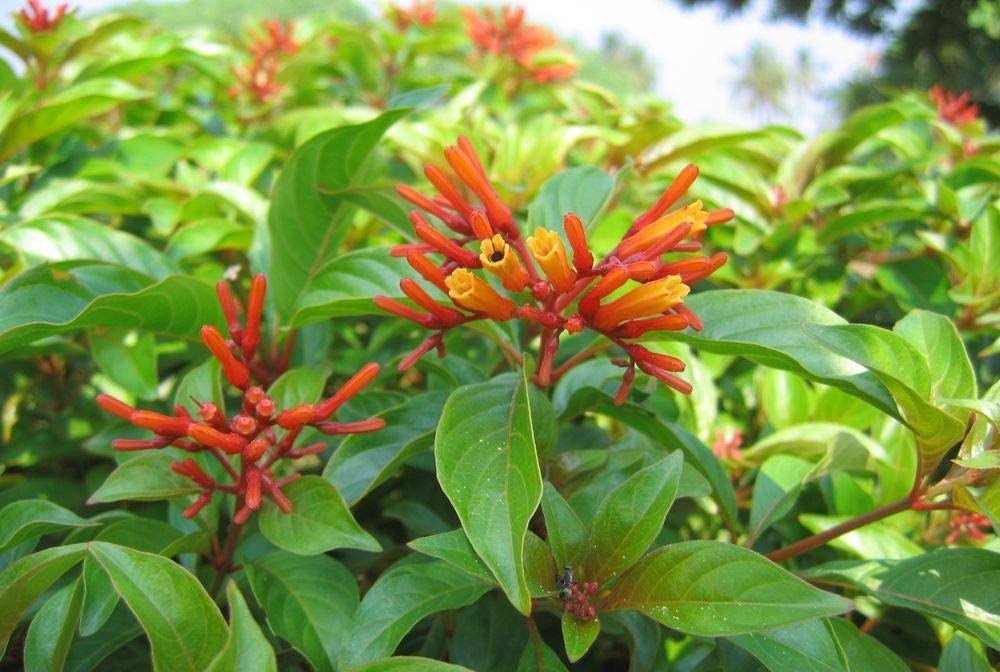
The Firebush is a small Florida flowering plant that can grow up to 3 feet tall. It is commonly found in Central and South Florida and has a compact growth habit. The attractive plant produces clusters of bright orange-red tubular blooms at the tips of its branches. The Firebush has evergreen foliage that consists of oval-shaped leaves with prominent pinkish veins. The lance-shaped leaves are about 6 inches long, while the individual flowers are 1 to 1.5 inches long. This fast-growing perennial thrives in warm winter climates and is ideal as an evergreen hedge, border plant, or container garden in Florida.
Hardiness zones: 9 to 11
Sun exposure: Full sun or partial sun
Thunbergia
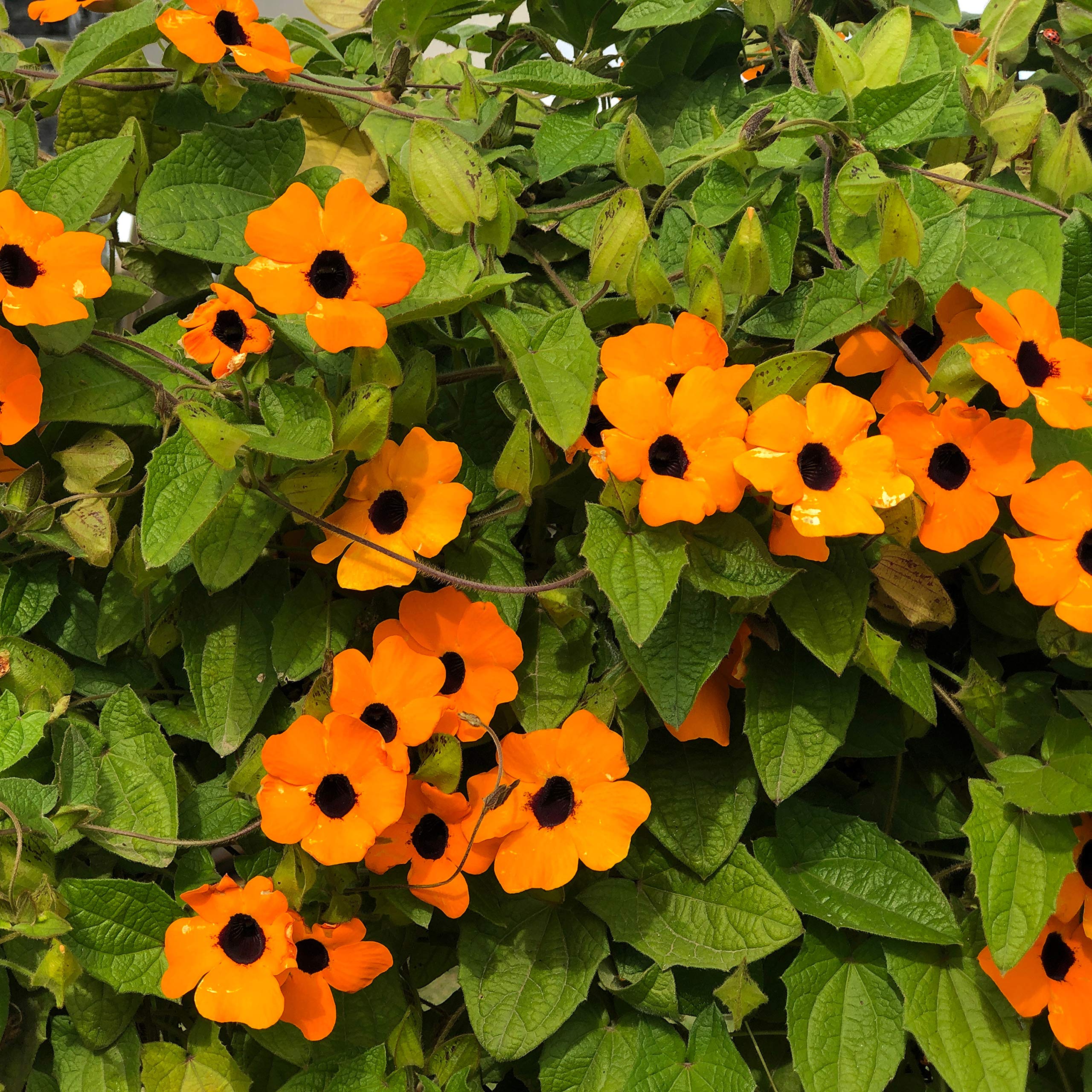
Thunbergia is a collection of flowering shrubs that grows well in subtropical and tropical areas, and it includes the vine-like shrub Thunbergia alata. The leafy shrubs produce large colorful flowers in pastel purple, blue, pink, white, and orange hues. The heart-shaped and bright green giant funnel-shaped blooms are abundant on long, drooping branches among heart-shaped leaves.
Thunbergia shrubs can reach up to 6 to 26 feet (1.8 to 8 meters) in height when grown as shrubs. The Thunbergia genus has several stunning vine plants that are ideal for subtropical regions, such as the black-eyed Susan vine (Thunbergia alata), which is a beautiful addition to any Florida garden.
Hardiness zones: 10 and 11
Sun exposure: Full sun to dappled shade
Coral Honeysuckle (Lonicera sempervirens)
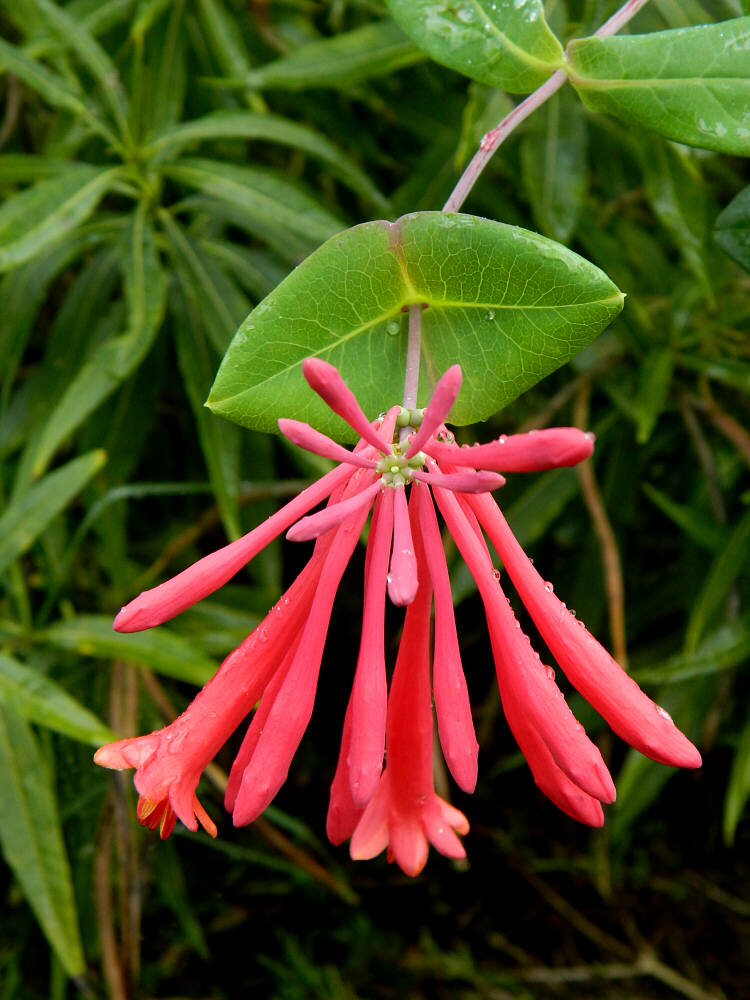
Coral honeysuckle is a climbing vine that produces scarlet tubular flowers and grows best in full sun but can tolerate partial shade. It is also called trumpet honeysuckle or scarlet honeysuckle. The vine has evergreen pointed leaves and red berries that appear during the summer and fall. It is perfect for decorating trellises, arbors, or fences, making it a great choice for gardeners. The deciduous twining coral honeysuckle vine can grow up to 20 feet (6 meters) or more if left unsupported, and its lanceolate leaves measure 2 inches (5 cm) long. The coral honeysuckle’s flowers are 2 inches (5 cm) long.
Hardiness zones: 4 to 9
Sun exposure: Full sun
Jamaica Caper (Capparis cynophallophora)
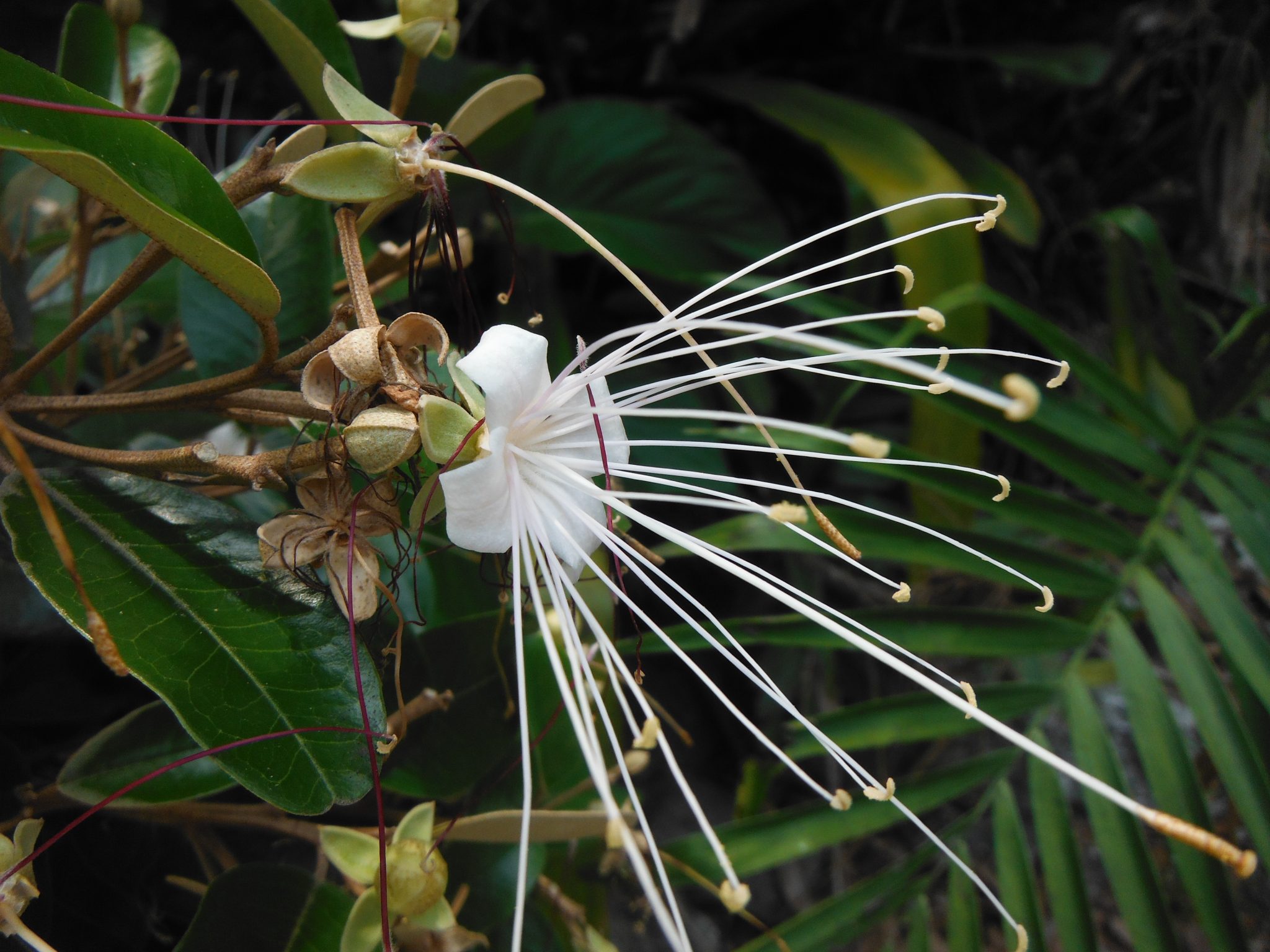
Jamaica caper is a shrub that thrives in partial sun to partial shade in South Florida. The glossy green oval leaves, beautiful purple, pink, or white flowers with long white stamens, and long cylindrical pods holding edible capers are the distinctive features of this plant. The flowering shrub can grow up to 6 to 15 feet (1.8 to 4.5 meters) tall and 8 to 12 feet (2.4 to 3.6 meters) wide. Oval leaves with notched tips, tiny showy flowers with 2″ (5 cm) long stamens, and lengthy bean-like seed pods ranging from 3″ to 8″ (7.5 – 20 cm) are all identifying characteristics of the Jamaica caper shrub.
Hardiness zones: 10 and 11
Sun exposure: Partial sun to partial shade
Evergreen Florida Shrubs
Croton (Codiaeum variegatum)
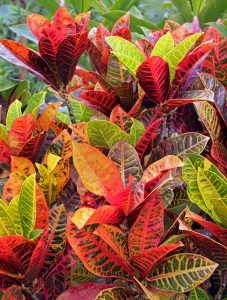
Croton plants come in various cultivars, with leaves of different colors such as red, purple, and yellow, making them an excellent addition to subtropical Central and South Florida landscapes. The shrubs are sun-loving and can grow up to 10 feet (3 meters) tall in small yards, but dwarf varieties are also available.
The colorful leaves of croton bushes are a standout feature, with stunning designs in shades of dark green, red, or yellow. The colorful streaks create a contrasting effect that adds to the plant’s beauty. Additionally, there are cultivars of croton plants with lance-shaped green leaves and yellow splashes.
Hardiness zones: 10 and 11
Sun exposure: Full sun to partial shade
Clusia (Clusia guttifera)

Clusia guttifera, also known as small leaf clusia, is a popular hedge plant in many parts of Florida. This shrub is distinguished by its leathery paddle-shaped leaves, thick foliage, and informal growth habit. Clusia is a popular hedge plant because it has evergreen leaves, low-branching patterns, and heat tolerance. It is also an excellent option for creating natural living barriers and privacy screens. With small leaves, Clusia shrubs can grow up to 25 feet (7.5 meters) tall. However, regular pruning can keep the hedge at a height of 3 to 5 feet (1.5 meters). Another common hedge plant in Florida is the Clusia rosea, which is also known as “Pitch Apple.”
Hardiness zones: 10 and 11
Sun exposure: Full sun
Bay Laurel (Laurus nobilis)
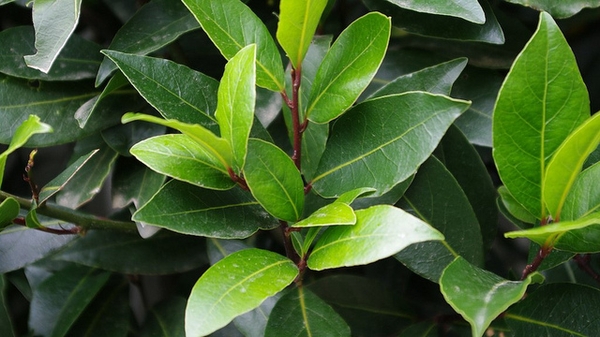
Bay laurel shrubs are a versatile addition to Florida gardens and can be shaped into topiaries or used as evergreen hedges. The thick foliage of the shrub has clusters of small, white flowers. While it can grow up to 25 feet (7.6 meters) in the wild, regular trimming can keep the large shrub at 2 to 8 feet (0.6 to 2.4 meters) in height in Florida’s humid climate.
Bay laurel plants thrive in oceanic climates and can be grown as an evergreen hedge, potted plant, or shaped into a topiary. The aromatic leaves of the bay laurel can also be dried and used as a spice in cooking, particularly in stews and soups. It is important to note that the bay laurel plant is unrelated to the cherry laurel plant.
Hardiness zones: 8 to 10
Sun exposure: Full to partial sun
Coralbean (Erythrina herbacea)

Coralbean is a flowering bush with thorny stems that can grow in all of Florida’s growing zones and thrives best in the south. The evergreen or deciduous Coralbean shrub has upright stalks with tubular flowers that bloom year-round. This ornamental shrub also has dangling seed pods and crescent-shaped blooms that add to its aesthetic appeal.
Coralbean shrubs can grow up to 6 to 12 feet (1.8 to 3.6 meters) in height and width. Tall spikes of crimson blooms range in height from 12 to 24 inches (30 to 60 cm). Coralbean thrives in temperate regions as a deciduous perennial that retreats in the winter and reappears in the spring. Coralbean is a perfect flowering shrub for Florida gardens that blooms throughout the year.
Hardiness zones: 8 to 11
Sun exposure: Full sun or partial sun
Privet Senna (Senna ligustrina)
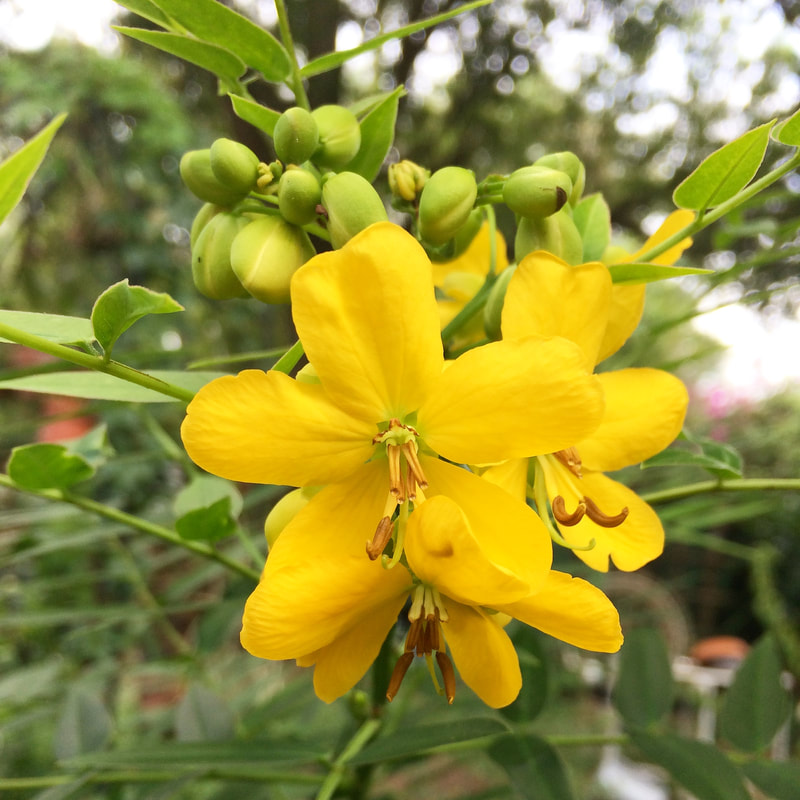
Privet senna is an evergreen perennial that thrives in warm climates and adds a touch of beauty with its yellow flowers, pinnately compound leaves, and long bean pods. The plant is known for its large, five-petalled yellow blooms and slender lanceolate leaflets.
The shrub is native to Florida and can grow up to 4-8 feet (1.2-2.4 meters) tall and broad. It blooms from fall through early summer, bringing vibrant yellow colors to any Florida garden. Privet senna can be grown as a specimen shrub to attract butterflies or used as a flowering shrub background.
Hardiness zones: 9-11
Sun exposure: Full sun
Southern Wax Myrtle (Morella cerifera)
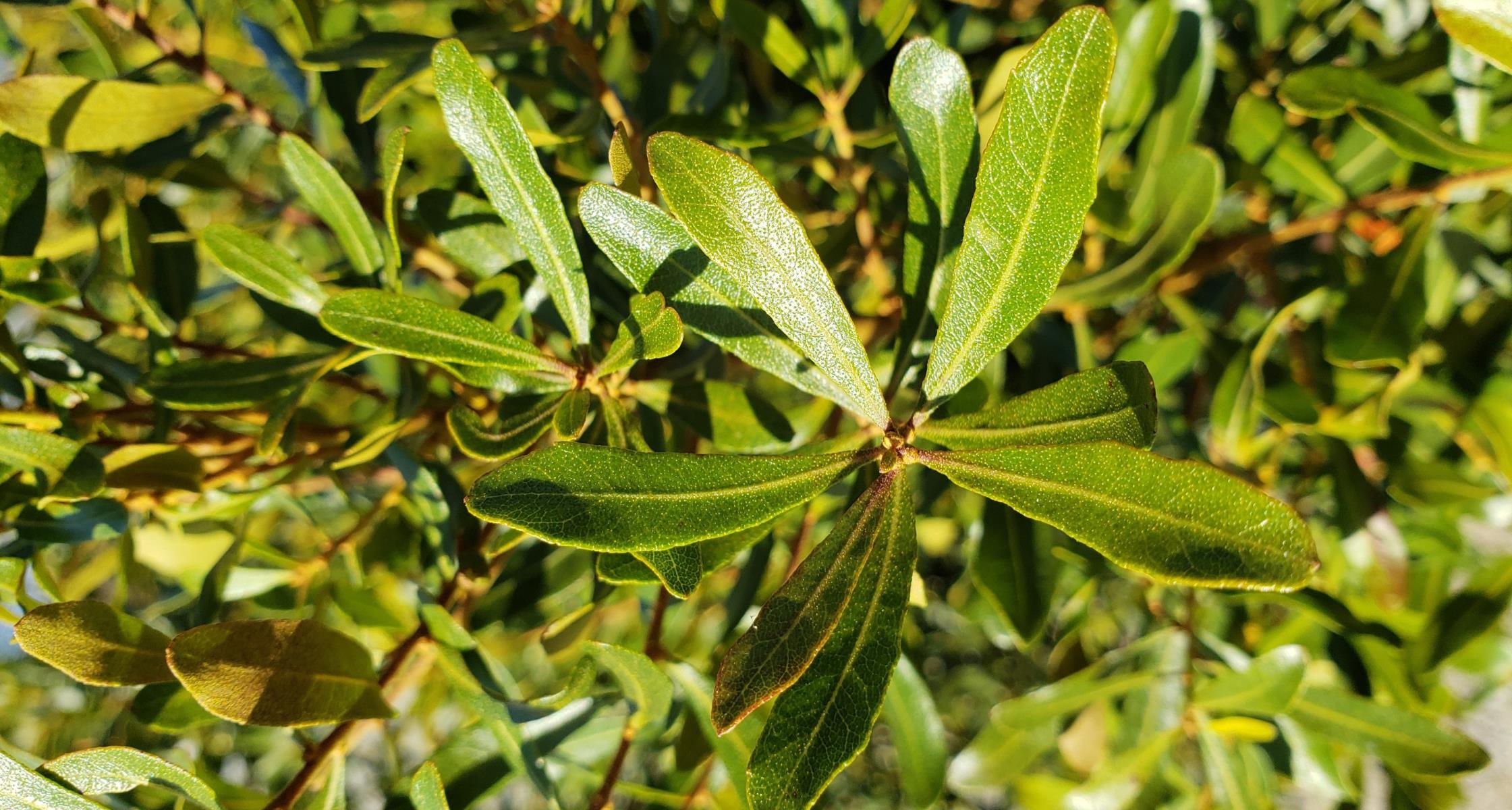
The wax myrtle shrub is a native plant that requires minimal care and flourishes in full sun. It is also called the southern bayberry. The multi-stemmed shrub can reach heights of 10 to 15 feet (3 to 5 meters) and have the same width. The plant has aromatic spring blooms, olive-green lanceolate leaves, and pale-blue berries.
Southern wax myrtle shrubs are perfect for full-sun landscapes in Florida. They are great for use as privacy screens, shrub borders, and evergreen hedgerows. The southern wax myrtle is tolerant of drought and flooding, making it ideal for planting near streams or wetlands.
Hardiness zones: 7 to 11
Sun exposure: Full sun to partial sun
Banana Shrub (Michelia figo)

The Purple Queen Michelia figo is a shrub that can withstand drought and produces purple flowers. This plant is commonly referred to as the Banana Shrub due to the banana-like fragrance that emanates from its magnolia-like blooms. The Banana Shrub is a drought-resistant plant that thrives in Florida’s humid climate. The shrub can grow up to 13 feet (4 meters) tall and produces fragrant, cream white, purple, or lilac-colored blooms with open petals. The dark green glossy leaves of the Banana Shrub are about 3 cm long.
Hardiness zones: 8 to 10
Sun exposure: Full sun to partial shade
Other Types of Florida Shrubs
Philodendron Xanadu
 Philodendron Xanadu is a shrub-like evergreen tropical plant with ten large lateral lobes on either side. Its leaves can reach up to 40 inches (100 cm) in length, and the clumping plant can grow to be 5 feet (1.5 meters) tall and 7 feet (2.1 meters) wide. Philodendron Xanadu can tolerate a wide range of light conditions, from full sun to full shade, making it an ideal plant for many Florida gardens.
Philodendron Xanadu is a shrub-like evergreen tropical plant with ten large lateral lobes on either side. Its leaves can reach up to 40 inches (100 cm) in length, and the clumping plant can grow to be 5 feet (1.5 meters) tall and 7 feet (2.1 meters) wide. Philodendron Xanadu can tolerate a wide range of light conditions, from full sun to full shade, making it an ideal plant for many Florida gardens.
Hardiness zones: 10 and 11
Nandina (Nandina domestica)
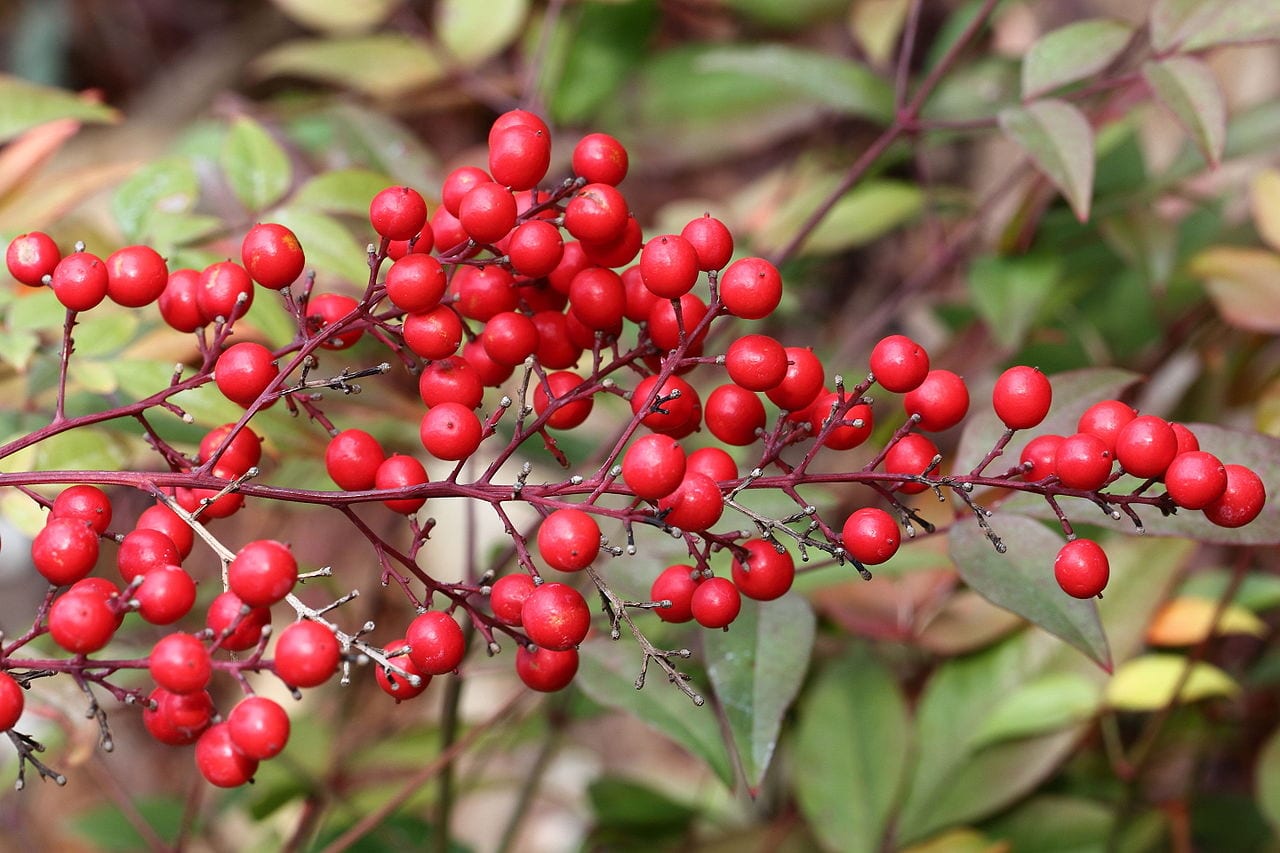
Nandina is a commonly cultivated ornamental shrub in Florida, appreciated for its attractive pointed red leaves, clusters of red berries, and tiny white flowers that turn crimson in the fall. Heavenly bamboo is the other name by which this heat-tolerant shrub is known. Nandina can grow up to 4 to 8 feet (1.2 to 2.4 meters) tall and can spread up to 4 feet (1.2 meters) in width.
Hardiness zones: 6 to 9
Sun exposure: Full sun to partial sun
Florida Arrowroot or Coontie (Zamia pumila)
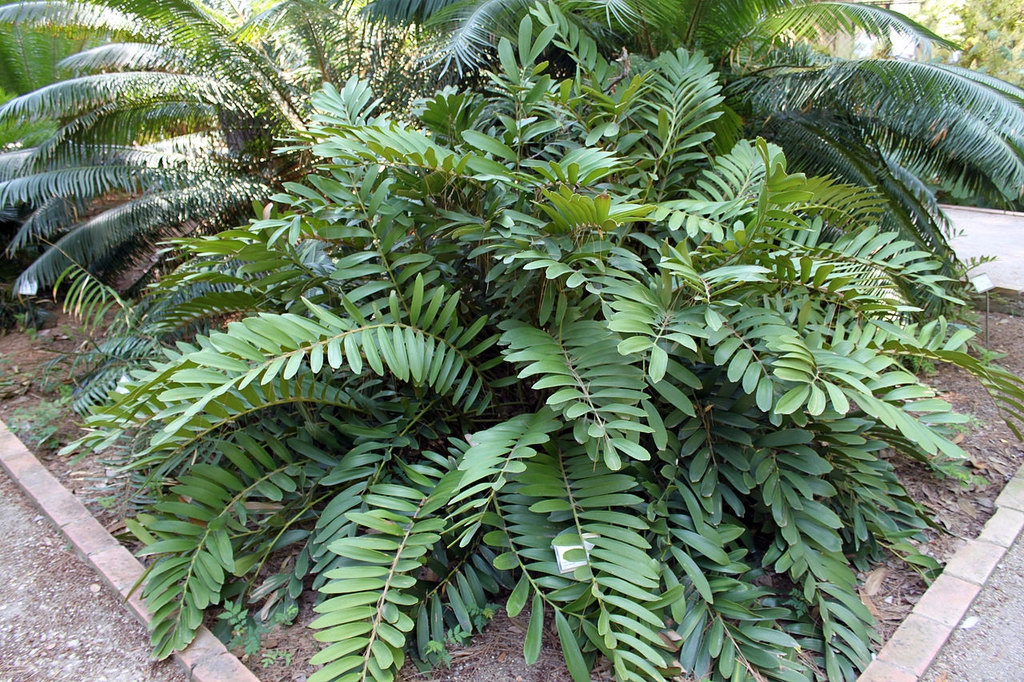
Coontie is a small, clumping plant with fern-like leaves that grows into a spreading habit and can be grown as a low shrub in full to partial sunlight. This showy evergreen plant grows as a shrub-sized cycad, but it is not a shrub. It is characterized by its pinnate leaves, reddish-brown ovoid cones, and brilliant orange seeds. The plant can grow up to 3 feet tall and has a width of 4 feet. Coontie can be used in landscaping, as a groundcover, or as an ornamental plant in gardens.
Hardiness zones: 8 to 11
Sun exposure: Full sun to partial sun
American Beautyberry (Callicarpa americana)
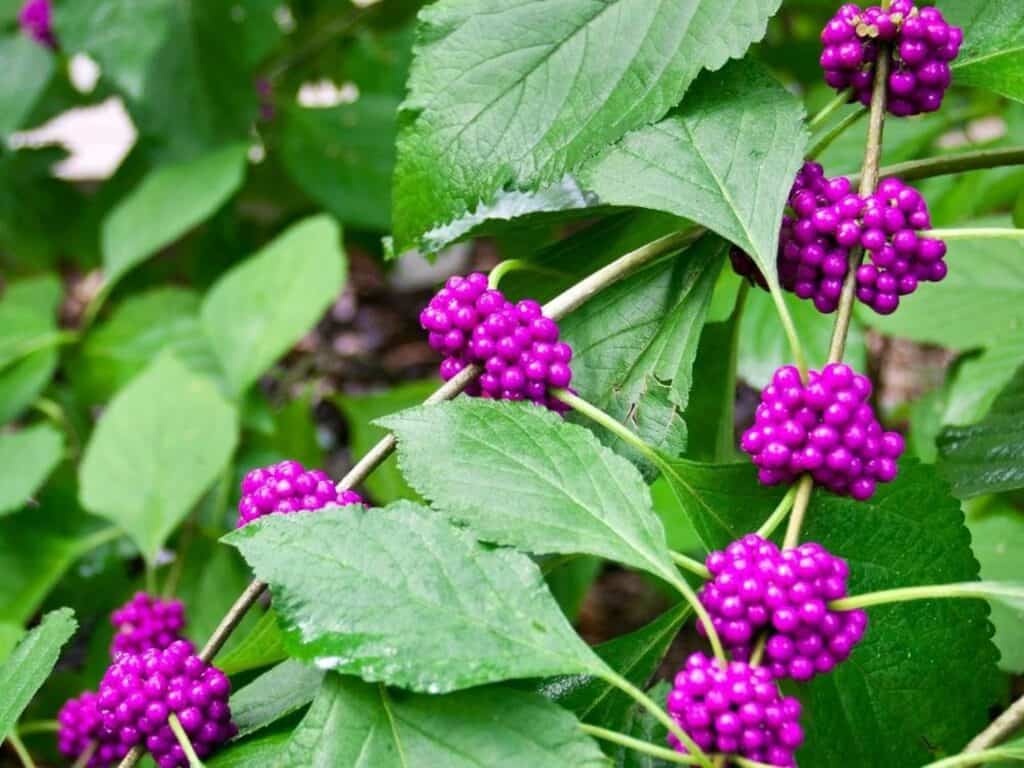
American beautyberry is an ornamental shrub that produces beautiful purple or magenta berries and grows well in Florida. Its open, loose structure and arching stems make it suitable for all parts of Florida. These bright berries persist on the plant throughout fall and much of the winter. The American beautyberry shrub typically grows 3 to 6 feet (0.9 to 1.8 meters) tall and wide.
Hardiness zones: 6 to 11
Sun exposure: Full sun to partial sun
Saw Palmetto (Serenoa repens)

Saw palmetto is a clumping palm tree that grows natively in Florida. Its distinctive coiling growth and evergreen spiky leaves, which can reach up to 3 feet in diameter, set it apart from other palms. Saw palmetto is a popular ornamental plant that is commonly used as a foundation plant or for texture accents along walkways. The multi-trunked tree, which has a shrub-like appearance, can grow up to 5 to 10 feet (1.5-3 meters) tall and wide.
Hardiness zones: 8 to 11
Sun exposure: Full sun to full shade
Crown of Thorns (Euphorbia milii)
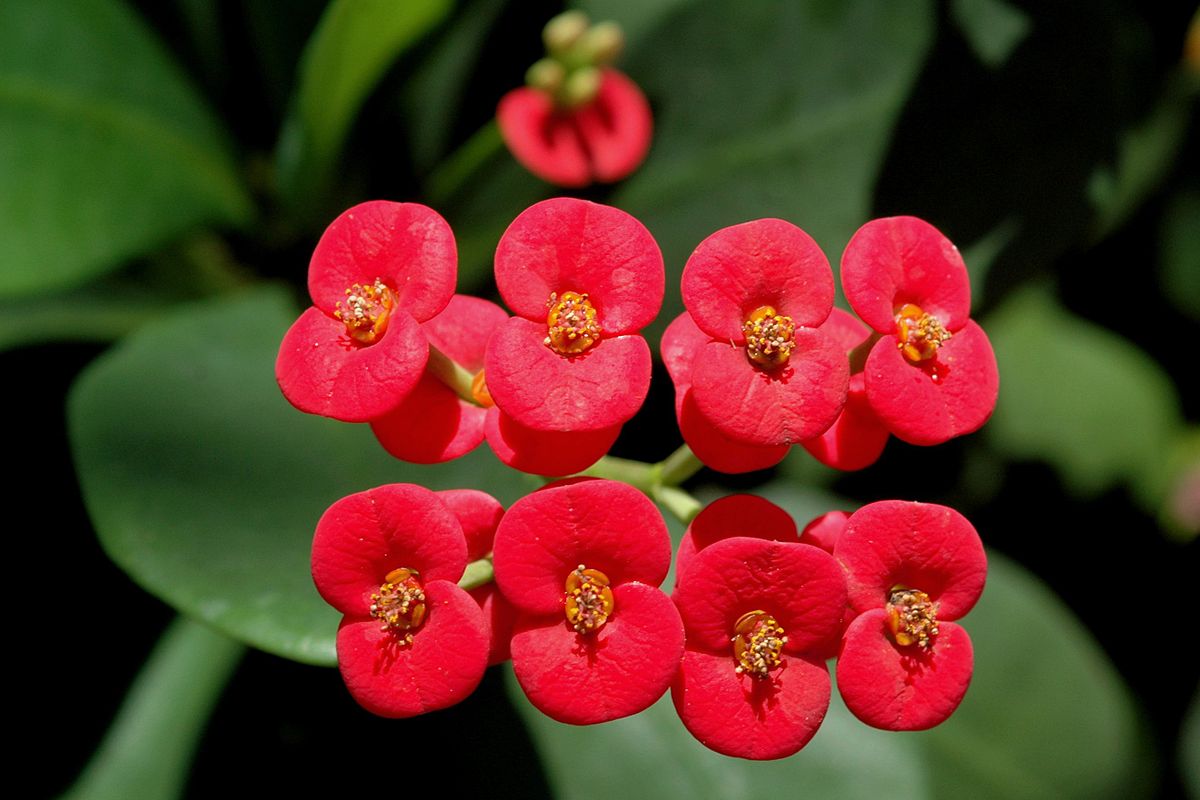
The crown of thorns is a small flowering shrub with greenish flowers, surrounded by bright red, pink, or yellow bracts that thrives in Florida gardens. It grows up to 3 to 6 feet (1.8 to 1.8 meters) tall and blooms all year long in southern climates. The plant is characterized by its small, spiky thorns and is a great addition to any full sun garden.
Hardiness zones: 9-11
Sun exposure: Full sun
Florida Boxwood (Schaefferia frutescens)
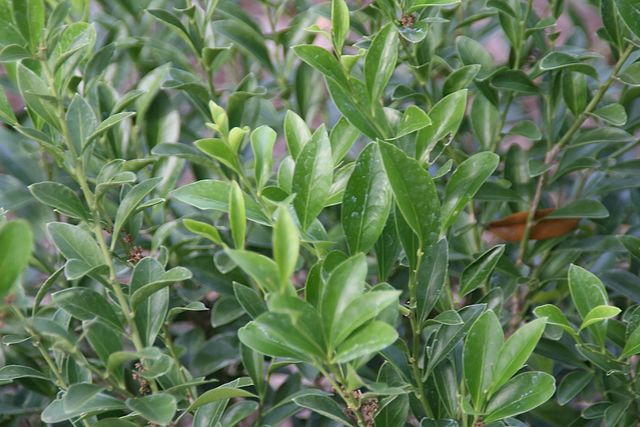
The Florida boxwood is a small evergreen shrub with leathery, yellowish-green leaves that can be pruned to form a hedge. It grows quickly and can reach heights of up to 20 feet (6 meters). With regular trimming, it can be trained into a formal hedge or privacy screen and is well-suited to Florida’s hot climate.
Hardiness zones: 10 and 11
Sun exposure: Full sun to partial shade
Chinese Fringe Flower (Loropetalum chinense)
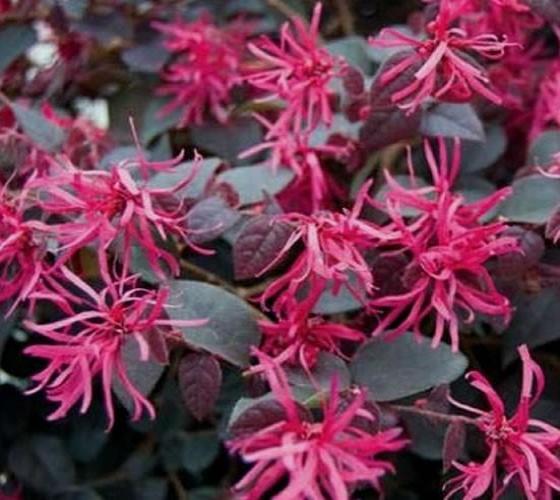
The Chinese fringe flower is a small and colorful shrub commonly found in Florida gardens, with bright green foliage and scarlet flowers that have long, thin petals. This heat and humidity-tolerant plant is known for its crimson-colored leaves and thrives in the Florida climate. To encourage vibrant red leaves and fuchsia pink blooms, it should be planted in full sun and watered regularly. The compact mounding shrub typically grows up to 4 feet (1.2 meters) tall and wide, with dark red leaves that add an extra pop of color to any landscape.
For a Florida garden with red or dark purple leaves and beautiful neon-pink, spidery blooms, suppose you need an easy-care shrub. In that instance, the Chinese fringe flower is a good option.
Hardiness zones: 7 to 10
Sun exposure: Full sun to partial shade
Umbrella Plant (Schefflera arboricola)

The dwarf umbrella tree or Schefflera arboricola has various cultivars that exhibit variegated leaves and clusters of crimson or burgundy flowers. It is a broad-leaved shrubby plant that grows to a height of 5 feet (1.5 meters) and 3 feet (1 meter) wide. The plant is also called the dwarf Hawaiian Schefflera and is well-known for its palm-like leaves with glossy green leaflets that are obovate in shape. The evergreen leaves of the umbrella tree can grow up to 8 inches (20 cm) in length and 4 inches (10 cm) in width.
Hardiness zones: 10 to 12
Sun exposure: Full sun with some shade protection in the afternoon
Copperleaf Plant (Acalypha wilkesiana)
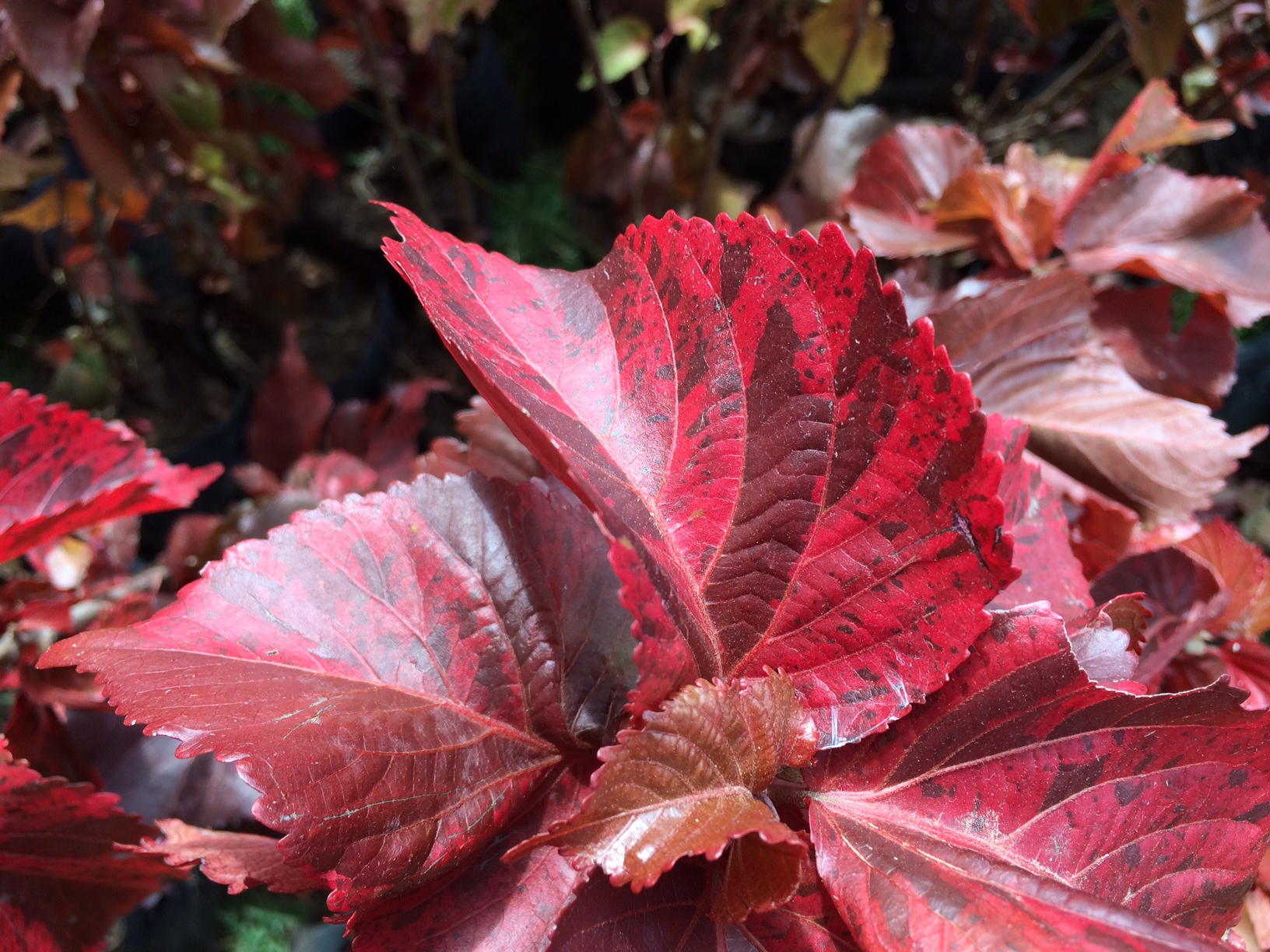
The copperleaf is an eye-catching leafy shrub that is ideal for Florida gardens, growing up to 10 feet (3 meters) tall and 6.5 feet (2 meters) wide. Its heart-shaped leaves, which measure 8 inches (20 cm) in width, are crimson in color and have serrated edges. The shrub’s nettle-like leaves are green with a coppery hue and come in various cultivars, providing year-round color to southern gardens.
To promote the growth of this red-leaved shrub, ensure that it is watered sufficiently, placed in full sun, and protected from strong winds. The colorful shrub can be used as a border plant, planted in front of the house, or grown in a mixed hedge. It is also known as the lance copperleaf or Jacob’s coat.
Hardiness zones: 10 and 11
Sun exposure: Full sun to partial shade.
